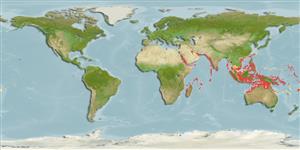>
Eupercaria/misc (Various families in series Eupercaria) >
Labridae (Wrasses)
Etymology: Paracheilinus: Greek, para = the side of + Greek, chaite = hair + Greek, odous = teeth (Ref. 45335).
More on authors: Randall & Harmelin-Vivien.
Environment: milieu / climate zone / depth range / distribution range
Écologie
marin récifal; profondeur 5 - 50 m (Ref. 90102), usually 5 - 40 m (Ref. 27115). Tropical; 25°C - 28°C (Ref. 27115)
Indo-West Pacific: western Indian Ocean to Fiji. Questionable record from Indonesia (Ref. 8631).
Taille / Poids / Âge
Maturity: Lm ? range ? - ? cm
Max length : 8.0 cm TL mâle / non sexé; (Ref. 11441)
Description synthétique
Clés d'identification | Morphologie | Morphométrie
Only the first dorsal soft ray prolonged in adults; penultimate dorsal soft ray of males 1.6-2.0 in HL; a single short dark stripe beneath pectoral fin (Ref. 41634).
Inhabits outer reef slopes, over rubble, algae, or coral (Ref. 9710). Occurs in small groups of mix sexes but females outnumber males greatly (Ref. 48636). Swim close to the bottom and females swim in small groups. Males swim around them and often hurry from one area to another where there are groups of females. Some juveniles are secretive and often single or small groups amongst the rubble (Ref. 48636).
Life cycle and mating behavior
Maturities | Reproduction | Spawnings | Egg(s) | Fecundities | Larves
Oviparous, distinct pairing during breeding (Ref. 205).
Randall, J.E. and R. Lubbock, 1981. Labrid fishes of the genus Paracheilinus, with descriptions of three new species from the Philippines. Jap. J. Ichthyol. 28(1):19-30. (Ref. 2139)
Statut dans la liste rouge de l'IUCN (Ref. 130435)
Menace pour l'homme
Harmless
Utilisations par l'homme
Pêcheries: commercial; Aquarium: Commercial
Outils
Articles particuliers
Télécharger en XML
Sources Internet
Estimates based on models
Preferred temperature (Ref.
123201): 26.2 - 29.1, mean 28.2 °C (based on 1868 cells).
Phylogenetic diversity index (Ref.
82804): PD
50 = 0.5000 [Uniqueness, from 0.5 = low to 2.0 = high].
Bayesian length-weight: a=0.00955 (0.00456 - 0.02002), b=3.06 (2.89 - 3.23), in cm total length, based on LWR estimates for this (Sub)family-body shape (Ref.
93245).
Niveau trophique (Ref.
69278): 3.4 ±0.45 se; based on food items.
Résilience (Ref.
120179): Haut, temps minimum de doublement de population inférieur à 15 mois (Preliminary K or Fecundity.).
Fishing Vulnerability (Ref.
59153): Low vulnerability (10 of 100).
Nutrients (Ref.
124155): Calcium = 138 [79, 283] mg/100g; Iron = 1.06 [0.60, 2.06] mg/100g; Protein = 18.1 [15.2, 20.3] %; Omega3 = 0.178 [0.099, 0.313] g/100g; Selenium = 24.9 [13.0, 50.2] μg/100g; VitaminA = 242 [72, 905] μg/100g; Zinc = 2.04 [1.31, 3.24] mg/100g (wet weight);
